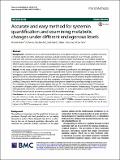Por favor, use este identificador para citar o enlazar a este item:
http://hdl.handle.net/10261/169791COMPARTIR / EXPORTAR:
 SHARE SHARE
 CORE
BASE CORE
BASE
|
|
| Visualizar otros formatos: MARC | Dublin Core | RDF | ORE | MODS | METS | DIDL | DATACITE | |

| Título: | Accurate and easy method for systemin quantification and examining metabolic changes under different endogenous levels |
Autor: | Pastor Fuentes, María Victoria; Sánchez-Bel, Paloma CSIC ORCID; Gamir, Jordi CSIC ORCID; Pozo Jiménez, María José; Flors, Victor CSIC ORCID | Fecha de publicación: | 2018 | Editor: | BioMed Central | Citación: | Plant Methods 14 (2018) | Resumen: | Background: Systemin has been extensively studied since it was discovered and is described as a peptidic hormone in tomato plants and other Solanaceae. Jasmonic acid and systemin are proposed to act through a positive feed-back loop with jasmonic acid, playing synergistic roles in response to both wounding and insect attack. Despite its biological relevance, most studies regarding the function of systemin in defence have been studied via PROSYSTEMIN (PROSYS) gene expression, which encodes the propeptide prosystemin that is later cleaved to systemin (SYS). Interestingly, hardly any studies have been based on quantification of the peptide. Results: In this study, a simple and accurate method for systemin quantification was developed to understand its impact on plant metabolism. The basal levels of systemin were found to be extremely low. To study the role of endogenous systemin on plant metabolism, systemin was quantified in a transgenic line overexpressing the PROSYS gene (PS+) and in a silenced antisense line (PS-). We evaluated the relevance of systemin in plant metabolism by analysing the metabolomic profiles of both lines compared to wildtype plants through untargeted metabolomic profiling. Compounds within the lignan biosynthesis and tyrosine metabolism pathways strongly accumulated in PS+ compared to wild-type plants and to plants from the PS- line. The exogenous treatments with SYS enhanced accumulation of lignans, which confirms the role of SYS in cell wall reinforcement. Unexpectedly, PS+ plants displayed wild-type levels of jasmonic acid (JA) but elevated accumulation of 12-oxo-phytodienoic acid (OPDA), suggesting that PS+ should not be used as an over-accumulator of JA in experimental setups. Conclusions: A simple method, requiring notably little sample manipulation to quantify the peptide SYS, is described. Previous studies were based on genetic changes. In our study, SYS accumulated at extremely low levels in wild-type tomato leaves, showed slightly higher levels in the PROSYSTEMIN-overexpressing plants and was absent in the silenced lines. These small changes have a significant impact on plant metabolism. SA and OPDA, but not JA, were higher in the PROSYS-overexpressing plants. | Versión del editor: | https://plantmethods.biomedcentral.com/articles/10.1186/s13007-018-0301-z | URI: | http://hdl.handle.net/10261/169791 | DOI: | 10.1186/s13007-018-0301-z | Identificadores: | doi: 10.1186/s13007-018-0301-z issn: 1746-4811 |
| Aparece en las colecciones: | (EEZ) Artículos |
Ficheros en este ítem:
| Fichero | Descripción | Tamaño | Formato | |
|---|---|---|---|---|
| 2018_Pastor_PM.pdf | 1,9 MB | Adobe PDF |  Visualizar/Abrir |
CORE Recommender
PubMed Central
Citations
7
checked on 18-abr-2024
SCOPUSTM
Citations
12
checked on 10-abr-2024
WEB OF SCIENCETM
Citations
12
checked on 27-feb-2024
Page view(s)
247
checked on 17-abr-2024
Download(s)
190
checked on 17-abr-2024

